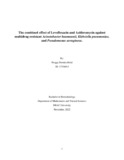| dc.contributor.advisor | Hossain, M. Mahboob | |
| dc.contributor.advisor | Ahmed, Akash | |
| dc.contributor.author | Belal, Progga Parmita | |
| dc.date.accessioned | 2023-05-15T10:29:14Z | |
| dc.date.available | 2023-05-15T10:29:14Z | |
| dc.date.copyright | 2022 | |
| dc.date.issued | 2022-11 | |
| dc.identifier.other | ID: 17336013 | |
| dc.identifier.uri | http://hdl.handle.net/10361/18294 | |
| dc.description | This thesis is submitted in partial fulfillment of the requirements for the degree of Bachelor of Science in Biotechnology 2022. | en_US |
| dc.description | Catalogued from PDF version of thesis. | |
| dc.description | Includes bibliographical references (pages 61-64). | |
| dc.description.abstract | Pneumonia affects everyone, particularly young children under the age of five. Acinetobacter
baumannii, Klebsiella pneumonia, and Pseudomonas aeruginosa are one of the main causes of
pneumonia as they cause a wide range of diseases which includes lung infections (pneumonia),
bloodstream infections, wound or urinary tract infections. A. baumannii has become a major public
health threat because 63 percent of Acinetobacter strains are multidrug-resistant.
The purpose of this study is to develop a viable method for battling infections brought about by
multidrug-resistant Acinetobacter baumannii, Klebsiella pneumonia, and Pseudomonas
aeruginosa in Bangladesh. From gathered bacterial samples, 10 out of 18 samples were multiple
antibiotic resistant which was identified by performing an antibiogram utilizing 18 different
antibiotics from 13 of various classes including Macrolides, Polymyxins, Tetracycline,
Nitroimidazole, Cephalosporin, Beta-lactam, Quinolone, Fluoroquinolones, Aminoglycosides,
and Penicillin. Then, primary screening of antibiotic susceptibility was done which categorized
the pathogens into multidrug-resistant, extensively drug-resistant (XDR), and pan-drug-resistant
(PDR). Next, by using the Minimum Inhibitory Concentration (MIC) method, individual
antibiotics and a combination of screened antibiotics activity were measured. Afterward, the
Fractional Inhibitory Concentration (FIC) index to provide statistical substantiation of results. The
highest demonstrated MIC value for Levofloxacin was 400 μg/ml, while the lowest was 50 μg/ml.
The highest value for Azithromycin was 400 μg/ml and the lowest was 100 μg/ml. For
Acinetobacter baumannii, Klebsiella pneumonia, and Pseudomonas aeruginosa samples, a
synergic effect was found in Levofloxacin in combination with azithromycin determined by FIC
Index was below 0.5 suggesting the synergistic effect of their combination.
The research result is very significant because by using a combination of antibiotics, the needed
amount of antibiotics on resistant pathogens can be decreased. This study has far-reaching
consequences for the future of combination therapy against multidrug-resistant bacteria. | en_US |
| dc.description.statementofresponsibility | Progga Parmita Belal | |
| dc.format.extent | 68 pages | |
| dc.language.iso | en | en_US |
| dc.publisher | Brac University | en_US |
| dc.rights | Brac University theses are protected by copyright. They may be viewed from this source for any purpose, but reproduction or distribution in any format is prohibited without written permission. | |
| dc.subject | Levofloxacin | en_US |
| dc.subject | Azithromycin | en_US |
| dc.subject | Multidrug-resistant | en_US |
| dc.subject | Acinetobacter baumannii | en_US |
| dc.subject | Klebsiella pneumoniae | en_US |
| dc.subject | Pseudomonas aeruginosa. | en_US |
| dc.subject.lcsh | Acinetobacter. | |
| dc.subject.lcsh | Pseudomonas aeruginosa infections | |
| dc.subject.lcsh | Drug resistance in microorganisms. | |
| dc.title | The combined effect of Levofloxacin and Azithromycin against multidrug-resistant Acinetobacter baumannii, Klebsiella pneumoniae, and Pseudomonas aeruginosa. | en_US |
| dc.type | Thesis | en_US |
| dc.contributor.department | Department of Mathematics and Natural Sciences, Brac University | |
| dc.description.degree | B. Biotechnology | |

